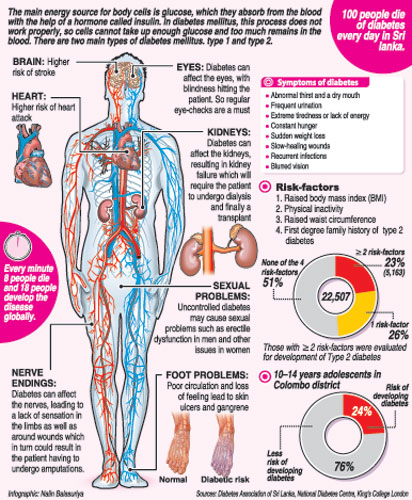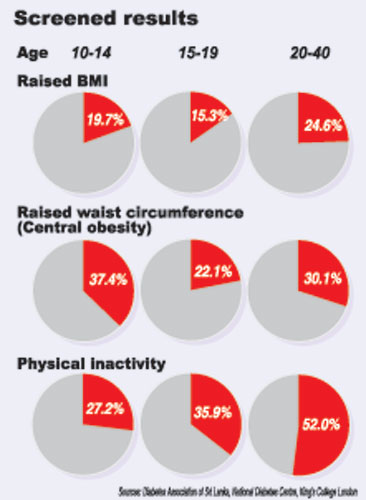| The “bitter” truth is out. One in four urban adolescents in Sri Lanka is sliding down a slippery slope into an abyss where diabetes awaits them, a survey has found.
This first-ever Sri Lankan survey of ‘young persons’ which screened them for the risk factors for diabetes, reflecting the trends in South Asia, has thrown up startling but not unexpected results. Titled ‘DIABRISK-SL’, the on-going research has found that 24% of adolescents between 10-14 years had two or more risk factors for the development of Type 2 diabetes. The risk factors include increased body mass index (BMI), raised waist circumference, high levels of physical inactivity and first-degree family history, the Sunday Times understands.
 |
|
The most significant risk factor detected among the 10-40 age group was physical inactivity which had an overall prevalence of about 45% (nearly half), while the prevalence of central obesity (fat around the waist) was 38%, with more females than males being prone to this risk factor. Nearly 25% were also overweight and obese. Central obesity among those in the 15-19 age group was 22.1%, once again with a greater female preponderance, the study has uncovered.
‘DIABRISK-SL’ in the urban young which is due to be completed in 2014 covers children including adolescents in the 10-17 age group and adults in the 18-40 age group.
A red signal has gone out with the baseline data revealing alarming trends in abnormal glucose levels in the blood (blood sugar) of our youth, says Dr. Mahen Wijesuriya of the National Diabetes Centre of Sri Lanka, stressing that simple cost-effective lifestyle modifications are essential to ward off this disease and “non-action is not an option”.
While there are more than 100 deaths due to diabetes and cardiovascular disease every day, earlier studies have found that 1 in 5 persons in Sri Lanka has either diabetes or is in the pre-diabetes danger category.
For, even during this study carried out among healthy children and adults in the 10-40 age-groups, 16% had been newly-diagnosed with pre-diabetes, which is a forerunner to diabetes, while 2.5% had diabetes.
Research Co-ordinator Laksha Vasantharajah also of the National Diabetes Centre explains that a person who has a fasting blood sugar (FBS) level of over 126mg/dl and/or an oral glucose tolerance test (GTT) level of over 200mg/dl is categorized as a diabetic. Anyone who falls between the 100-125 level for fasting blood sugar and 140-199 in the oral glucose tolerance test is considered a pre-diabetic. Diabetes and pre-diabetes are together called dysglycaemia and is indicative of the abnormal glucose levels in the blood.
Fanning out to 65 organizations in the Colombo district which included 15 schools, five universities, 38 workplaces and seven community organizations (“to catch the non-working mothers,” says Dr. Wijesuriya), the researchers screened 22,507 of whom 47% were males and 53% females between the 10-40 age-group for the four risk factors for diabetes – obesity, elevated waist circumference, family history and physical inactivity, it is learnt.
While Stage 1 of the study screened a representative sample of the general population in the Colombo district, the most-populous urban district in the country, for the risk-factors, in Stage 2 those in the high-risk category had been advised on lifestyle modification as part of a primary prevention intervention trial with follow-up action thereafter, it is understood.
The deadly combination of unhealthy food, lack of exercise and stress has been found to be the cause of the urban young falling into the grip of diabetes. “Many countries have studied the prevalence of diabetes in the over-20 category and we thought we will study the risk factors, pre-diabetes and diabetes in the under-20 age group,” explains Dr. Wijesuriya. It has also been established by previous studies that the prevalence of Type 2 diabetes, when comparing the rural-urban sectors, is double in urban areas.
Delving into the causes of Type 2 diabetes which are genetics, foetal origin (in the womb), lifestyle (both food and exercise) and stress, he points out that it is not a rich person’s disease. “It is a case of a transition from under-nutrition in the womb to over-nutrition in later life.”
With regard to the survey, he cites the case of a teenage ruggerite of a leading boys’ school in Colombo who was being “fed” by the school as it wished to fatten him under the misconception that he would then become stronger. Do you know what they gave him to eat, he asks, answering that daily he was on a “diet” of a kilo of meat, manioc and two large bottles of a carbonated sugary drink.
Another disturbing finding was that of 2,000 surveyed at a leading girls’ school, 1,200 were at high-risk of developing diabetes.
Pointing out that the survey follow-up is attempting to modify the wrong aspects of lifestyle through behavioural change, without medication, Dr. Wijesuriya advises that with regard to food three aspects need to be looked at – quality, quantity and timing.
Referring to quality, he says that as much as possible food and drink which are refined, polished or extracted should be avoided because they are of dubious value. Nature never produced anything without fibre and is good if people could stick to “natural products”, eating as much vegetable and fruit as possible and also fish and chicken but no red meat or processed food.
Quantity should be in small portions evenly distributed throughout the day to minimize hunger while the meals should also be timed so that a child would not gorge on food the moment it is put before him. Timing, according to Dr. Wijesuriya, is of utmost importance as delay would lead to over-eating, overweight and obesity, because hunger is the greatest force faced by human beings.
The other factor, of course is stress, he points out, insidiously present in most people who follow a modern lifestyle. “High expectations give rise to frequent failure of achievement and stress is the result. Lowering one’s expectations and being happy with one’s lot in life is the answer. Increase in the hours of study through school followed by extra tuition classes adds to stress.”
The initial findings of ‘DIABRISK-SL’ have been published in the prestigious PLoS ONE (Public Library of Science) in February and TRIALS in December last year.
This first large population based study is being carried out by a team comprising Dr. Wijesuriya and Ms. Vasantharajah of the Diabetes Association and National Diabetes Centre of Sri Lanka and Janaka Karalliedde, Giancarlo Viberti and Luigi Gnudi of the Cardiovascular Division, King’s College, London. |



